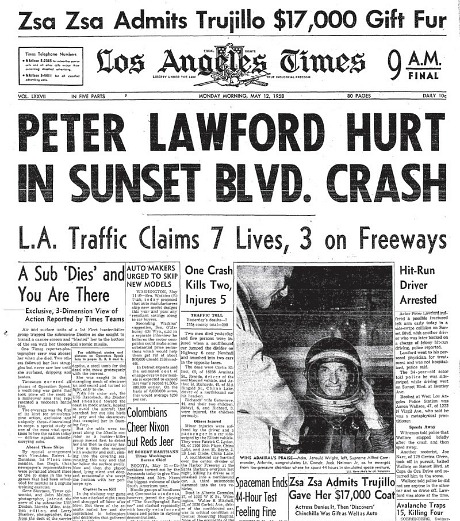Imagine the journalistic standards and criteria that led the Los Angeles Times to go with a front-page banner headline on May 12, 1958 about Peter Lawford, then a 34 year-old moderately famous TV actor (The Thin Man), having possibly fractured his arm in an auto accident on Sunset Blvd. And I mean especially considering that Lawford wasn’t even hospitalized but “went to his personal physician for treatment.”

Imagine the newsroom conversation between the front-page, straight-news editor and entertainment reporter who covered the Lawford accident.
Entertainment reporter: “I’ve got something that might be a page-one headline…you tell me. Peter Lawford was sideswiped by some guy on Sunset and might have fractured his arm.”
News editor: “Good God, Peter Lawford’s been hurt? I watch The Thin Man every week. Is he okay?”
Entertainment reporter: “Yeah, he’s all right. Arm’s in a cast but he’s fine.”
News editor: “But he was…what, run over?”
Entertainment reporter: “No, his car was hit and the impact…”
News editor: “Oh, right…”
Entertainment reporter: “His car was hit by this other guy who fled the scene, and Lawford’s arm was hurt.”
News editor: “Well, we have to send flowers or something. What hospital is he in?”
Entertainment reporter: “He’s not in a hospital. We went to his doctor and had a cast put on and went home.”
News editor: “So he’s okay. So…wait a minute, I don’t get this. Why is this a page-one headline?”
Entertainment reporter: “Maybe it isn’t. I’m just saying Lawford got hurt and he’s….he was MGM’s biggest star in the mid to late ’40s and…okay, he’s doing TV now but he hangs out with Frank Sinatra and is married to the sister of Senator Kennedy from Massachucetts, who might run for president so…we might want to give it some play.”
News editor: “But he didn’t even go to the hospital!”
News editor: “I know, it wasn’t that bad, but…I’m just telling you what happened. If it’s not big enough, fine. We’ll stick it in the movie section.”
News editor: “Let me think it over.”

